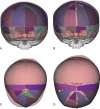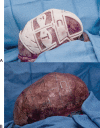Virtual surgical planning in craniofacial surgery
- PMID: 25210509
- PMCID: PMC4154978
- DOI: 10.1055/s-0034-1384811
Virtual surgical planning in craniofacial surgery
Abstract
The complex three-dimensional anatomy of the craniofacial skeleton creates a formidable challenge for surgical reconstruction. Advances in computer-aided design and computer-aided manufacturing technology have created increasing applications for virtual surgical planning in craniofacial surgery, such as preoperative planning, fabrication of cutting guides, and stereolithographic models and fabrication of custom implants. In this review, the authors describe current and evolving uses of virtual surgical planning in craniofacial surgery.
Keywords: cranial vault remodeling; craniofacial surgery; craniosynostosis; distraction osteogenesis; virtual surgical planning.
Figures






References
-
- Foley B D, Thayer W P, Honeybrook A, McKenna S, Press S. Mandibular reconstruction using computer-aided design and computer-aided manufacturing: an analysis of surgical results. J Oral Maxillofac Surg. 2013;71(2):e111–e119. - PubMed
-
- Hierl T, Arnold S, Kruber D, Schulze F P, Hümpfner-Hierl H. CAD-CAM-assisted esthetic facial surgery. J Oral Maxillofac Surg. 2013;71(1):e15–e23. - PubMed
-
- Nikkhah D, Ponniah A, Ruff C, Dunaway D. Planning surgical reconstruction in Treacher-Collins syndrome using virtual simulation. Plast Reconstr Surg. 2013;132(5):790e–805e. - PubMed
-
- Tepper O M, Sorice S, Hershman G N, Saadeh P, Levine J P, Hirsch D. Use of virtual 3-dimensional surgery in post-traumatic craniomaxillofacial reconstruction. J Oral Maxillofac Surg. 2011;69(3):733–741. - PubMed
LinkOut - more resources
Full Text Sources
Other Literature Sources

